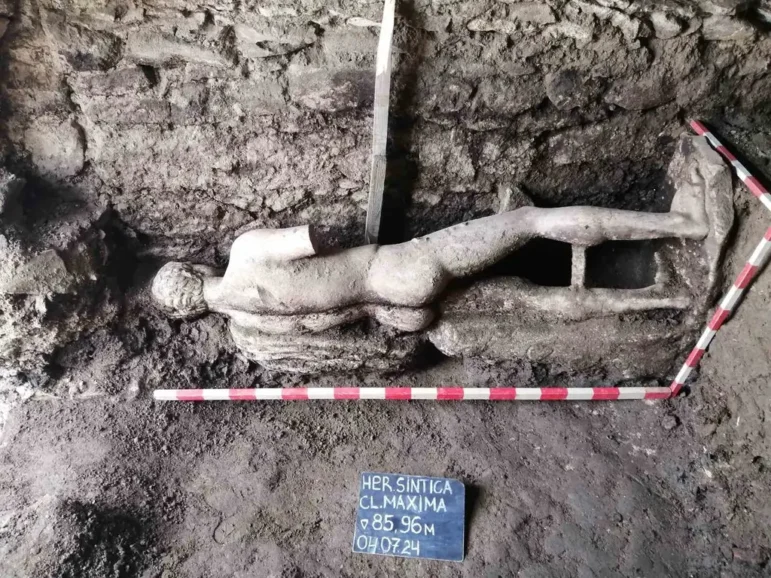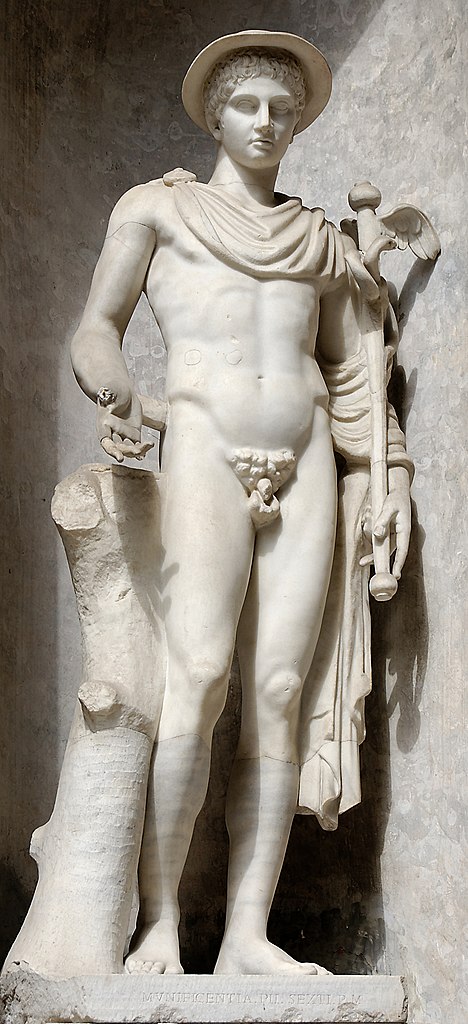Sofia, Bulgaria – Bulgarian archaeologists announced an unexpected discovery last week during a dig in an ancient Roman sewer: an exceptionally well-preserved marble statue. It is presumed to be the Greek god Hermes and was likely cast into the sewer when Christianity forbade all things pagan.
The 6.8-foot (2-meter) tall statue was found during excavation work at the site of the ancient city of Heraclea Sintica in southwestern Bulgaria, near the Greek border at Petrich. Hermes, the son of Zeus and Maia, is revered for his cunning and cleverness. He is a messenger of the gods and also guides souls to the underworld, acting as a psychopomp. Hermes holds many other roles, including being the god of trade, thieves, travelers, sports, and border crossings.
The statue is in remarkable condition. “Its head is preserved. It’s in very good condition. There are a few fractures on the hands,” said Prof. Dr. Lyudmil Vagalinski, who led the team of archaeologists, noting that the statue is a Roman copy of an ancient Greek original.

Statue of Hermes. Image Credit: Archaeologia Bulgarica
Vagalinski noted that the discovery was made in the Cloaca Maxima sewer, where archaeologists hardly expected to find anything. “My main concern in this area, where the big sewer is, is how to preserve the ancient structures we uncovered six years ago,” Vagalinski said. The area is privately owned, so the township cannot carry out permanent conservation and restoration activities as it would on municipal grounds. The statue’s location has crumbling structures and walls that are eroding, so the archaeologists decided to check on them by opening up the sewer grates they had installed for safety. “While sweeping the walls very carefully to assess their condition, we saw marble,” Vagalinski said, adding that the statue surfaced as they continued what he described more as a cleanup than excavation.
Heraclea Sintica was an ancient city located in the region of Macedonia, near the modern town of Rupite in southwestern Bulgaria. It was founded by Philip II of Macedon in the 4th century BCE. The city played an important role in the Hellenistic and Roman periods due to its strategic location along the Struma River and its proximity to key trade routes.
Archaeological evidence suggests that Heraclea Sintica was a thriving urban center with significant public buildings, including a theater, a forum, and various temples. The city is known for its well-preserved mosaics and inscriptions, which provide insights into the daily life, culture, and governance of its inhabitants. Heraclea Sintica continued to be an important settlement throughout the Roman Empire and into the early Byzantine period before eventually declining and being abandoned.
A powerful earthquake around 425 AD destroyed much of the city’s infrastructure, including the civic basilica, and caused the nearby Strumeshnitsa River to flood the forum. After 457 AD, groups of people returned to live in the ruins, but life in Heraclea gradually dissipated, with no signs of permanent habitation by 500 AD. Excavations at the site have been exceptionally fruitful, uncovering various artifacts that shed light on the city’s history and its interactions with neighboring regions.

Statue of Greek god Hermes, so-called “Hermes Ingenui”, carrying a winged caduceus upright in his left hand. Roman copy after a Greek original of the 5th century BCE. Museo Pio-Clementino, Vatican Museums, Rome [public domain]
Vagalinski explained that the marble statue had been placed in the sewer and covered with dirt, possibly due to the adoption of Christianity as the official religion of the Roman Empire and the subsequent ban on pagan symbols. “Everything pagan was forbidden, and they joined the new ideology,” he said. “But apparently, they still took care of their old deities.” The statue’s location in the sewer helped preserve it, and it was placed rather than cast aside there. Archaeologists reported that after the last earthquake that devastated the city around A.D. 388, the statue was carefully placed in the sewers and covered with soil, which explains its excellent condition.
Vagalinski noted that this season’s excavation in the ancient city will last between three and four months. The statue will remain in place until it can be fully recovered and moved. “Work is currently underway to fully uncover the figure. After that, it will be taken to the History Museum in Petrich,” he said.
The Wild Hunt is not responsible for links to external content.
To join a conversation on this post:
Visit our The Wild Hunt subreddit! Point your favorite browser to https://www.reddit.com/r/The_Wild_Hunt_News/, then click “JOIN”. Make sure to click the bell, too, to be notified of new articles posted to our subreddit.